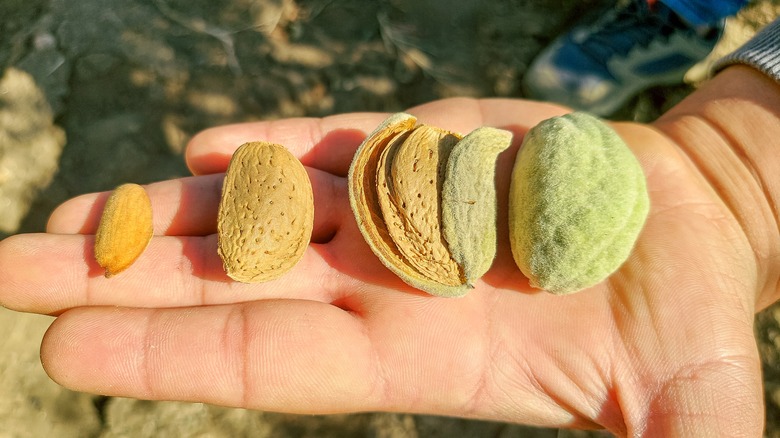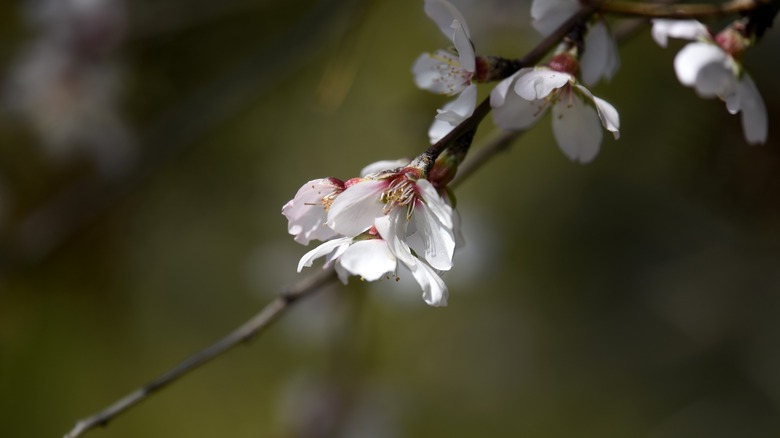“Look, almonds! Over there, growing on that tree.” Before you start stuffing nuts into your rucksack like a squirrel frantically preparing for the arrival of winter, you’d be wise to take a step back and look closely at the nut tree that’s bringing a bountiful harvest to your yard. Did you know edible sweet almonds look remarkably similar to their toxic cousins, bitter almonds? Cultural botanist Michael Peverett, writing in his eponymous blog, found out the hard way when sampling some almonds he found growing in the wild. Suffice it to say there was some lengthy mouth rinsing going on immediately following his short-lived feast.
The bitter almond — Prunus dulcis var. amara — is the result of a recessive gene in the sweet almond tree, Prunus dulcis. As such, the trees themselves look, even to the well-trained eye, identical. Prunus dulcis var. amara is far less commonly cultivated than its sweet counterpart, especially in the U.S.; a quick online search shows that you won’t find many, if any, Prunus dulcis var. amara saplings or seeds for sale. This already suggests it’s less likely to be the tree in your yard you’re trying to identify. That’s probably not enough of an identifier to set your mind at ease when you’re dealing with a plant that regularly has a poison warning next to its description. Differences between the width and length of the nuts, their taste and smell, along with each almond tree’s flowers, however, could be.
Study the nuts

To determine whether the tree you have in your backyard is a sweet or bitter almond, start by examining the nut. Experts suggest the bitter almond nut is slightly shorter and squatter than its safe-to-eat counterpart: a maximum of 0.8 inches long compared with the maximum of 1.2 inches for the sweet almond nut, per the Textbook of Pharmacognosy and Phytochemistry. Bitter almond nuts may also have a pointier end.
This is far from a fool-proof method. For one, you need to have at least one assuredly sweet almond nut to compare your bitter-or-not almonds against. And even if you have such a nut (or nuts), size can vary across varieties and even the output of individual trees. In a 2024 study published in OCL, researchers found the physical characteristics of the fruit of both bitter and sweet almond cultivars grown in different regions of Morocco varied by region and cultivar, rather than across bitter-sweet lines. This suggests that studying the nuts may not be a reliable way to tell one type of plant from another.
Crushing the nuts your tree produces into a milky paste with water can tell you if you have a bitter or sweet almond cultivar. The process produces hydrogen cyanide (also called hydrocyanic acid). Yup, that’s the cyanide of 1920s murder mysteries and spy novels. Cyanide has a distinctive almond scent — akin to marzipan — or smells like well-used sneakers — it’s easy to identify. The catch? Only some people can smell it.
Blooms and taste buds

The flowers of your almond tree may be another indicator of difference. According to some experts, the blooms of the bitter almond are typically white with a pink center, whereas sweet almond tree flowers boast petals hued pink to bright red. The usefulness and even accuracy of this evidence is questionable, however. The knowledge sources are old — in some cases, very old. Perhaps the most recent is an entry on the bitter almond in the Phil Bendle Collection, the compiled records of Phil Bendle, a prominent naturalist and botanical photographer from Aotearoa, New Zealand. Another reference, Trees and Shrubs for English Gardens, which seems to be the original source for this oft-repeated identifier, was published in 1908!
Taste is really the deciding factor when telling the difference between bitter and sweet almond trees. Bitter almond is so-called for the nut’s acerbic (read: extremely and immediately yucky) flavor. It’s an evolutionary adaption that helps take care of an almond tree by stopping hungry herbivores from browsing. According to a 2024 paper published in the Annals of Tropical Medicine and Public Health, the intense bitterness comes from a compound called amygdalin, which our bodies transform into the aforementioned hydrocyanic acid. Eating just six bitter almonds could land you in the hospital; consuming fifty could kill you. Please don’t eat an entire almond as a test. The tiniest of nibbles immediately spat out will quickly tell you what type of almond tree you’re growing.



